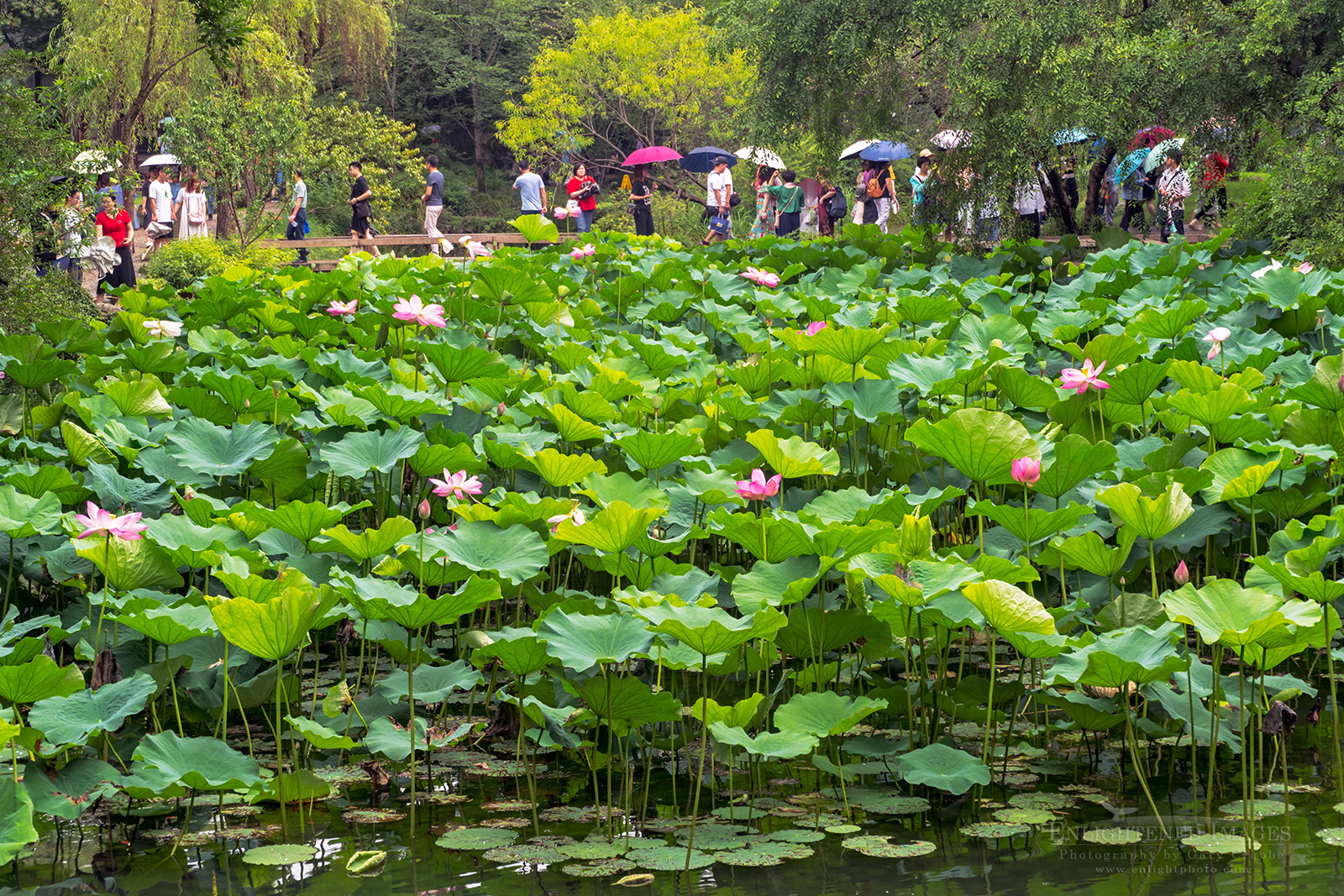
Photo: (Above) Visitors in The Humble Administrator Garden, a UNESCO World Heritage Site, Suzhou, Jiangsu Province, China
Two days spent visiting the gardens and canals of Suzhou, China.
Five Weeks in China; Part Two.
In my first (previous) post, I reported on how I came to spend nearly five and a half weeks visiting China this last summer; namely, a winding pathway that started when a friend living in China asked for a favor. It’s quite the wandering tale, but it outlines how I came to be here for so much time with absolutely no real purpose or agenda save for the modern version of an old-fashioned walkabout. My trip started by flying from San Francisco into Beijing followed by a domestic transfer to Shanghai. I arrived set with a four-night hotel reservation and a return flight home from Shanghai five weeks later. (I’ll cover Shanghai in a later post since it bookended my trip.} The trip was planned on the fly, such that once I was settled into one place, I began researching and booking my transportation and hotel for my next-leg destination in a very hopscotch/leapfrog manner.
 Photo: Golden dragon and mist in jewelry shop along Pingjiang Road, Suzhou, Jiangsu Province, China
Photo: Golden dragon and mist in jewelry shop along Pingjiang Road, Suzhou, Jiangsu Province, China
My friend who spent seven years teaching in China gave me some wonderful advice for beginning my trip by staying within what he called the Shanghai Bubble; a group of destinations within about 200 miles (400 km) from Shanghai. From a San Francisco Bay Area, California perspective, this would include distances to local places like Point Reyes National Seashore, Napa, Monterey, all the way across the state to Lake Tahoe or Yosemite. In China, this bubble included some of the popular tourist areas and historic water towns all the way to the more distant Huangshan (a.k.a. the Yellow Mountains).
Suzhou would be the first city outside of Shanghai where I’d spend a few days. A large urban area located about 70 miles northwest of Shanghai, Suzhou has a general population of more than 10 million people, nearly 3.5 times that of Chicago. This would also be my first time purchasing and getting tickets for the half-hour bullet train trip from Shanghai to Suzhou. (I’ll talk more about the experience of booking travel and hotels in China in a later post.) I knew from my research that I wanted to stay close to the main part of the old historic town center and the railroad station. I wound up staying in the Gusu District, (pop. 1 Mil.) just across the street from the train station at a place called Home Inn Selected (Suzhou Railway Station North Square).
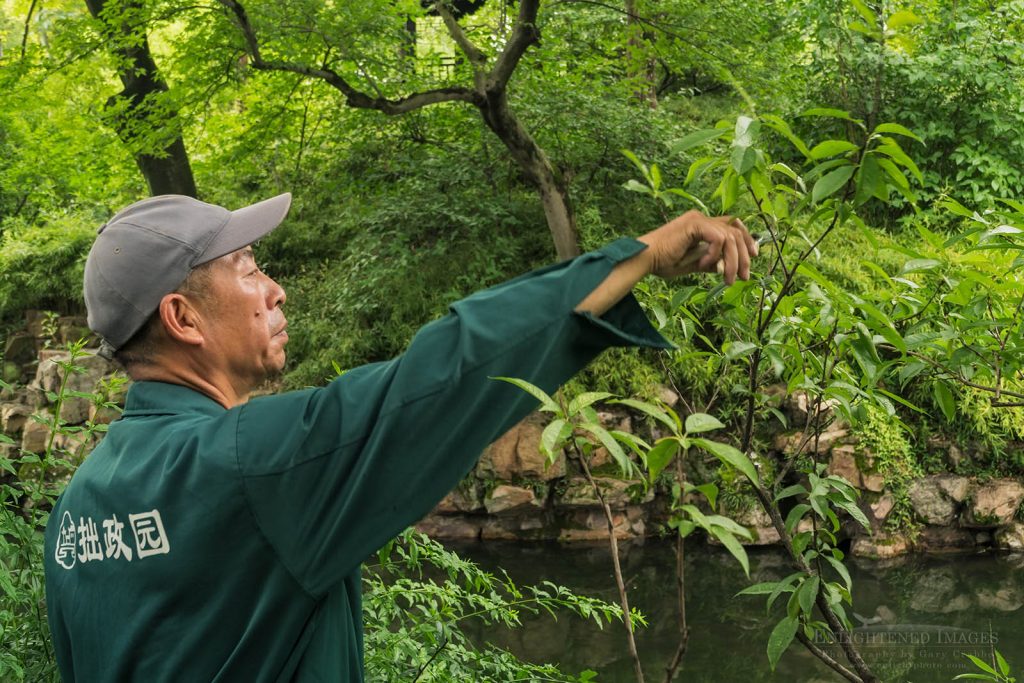 Photo: Gardener working on trimming plants in The Humble Administrator Garden, a UNESCO World Heritage Site, Suzhou, Jiangsu Province, China
Photo: Gardener working on trimming plants in The Humble Administrator Garden, a UNESCO World Heritage Site, Suzhou, Jiangsu Province, China
Suzhou’s history extends back over 2,500 years and is famous today for its silk and many ancient gardens that are hundreds of years old. In fact, Suzhou is home to nine ancient gardens that are now part of a collective UNESCO World Heritage Site known as The Classical Gardens of Suzhou. Since I was traveling solo and here for just a day and a half exploration, I didn’t get to explore too much of the silk history and production, visit any of the pagodas, parks, or the nearby Suzhou Museum which was designed by I.M. Pei. Those will be for next time.
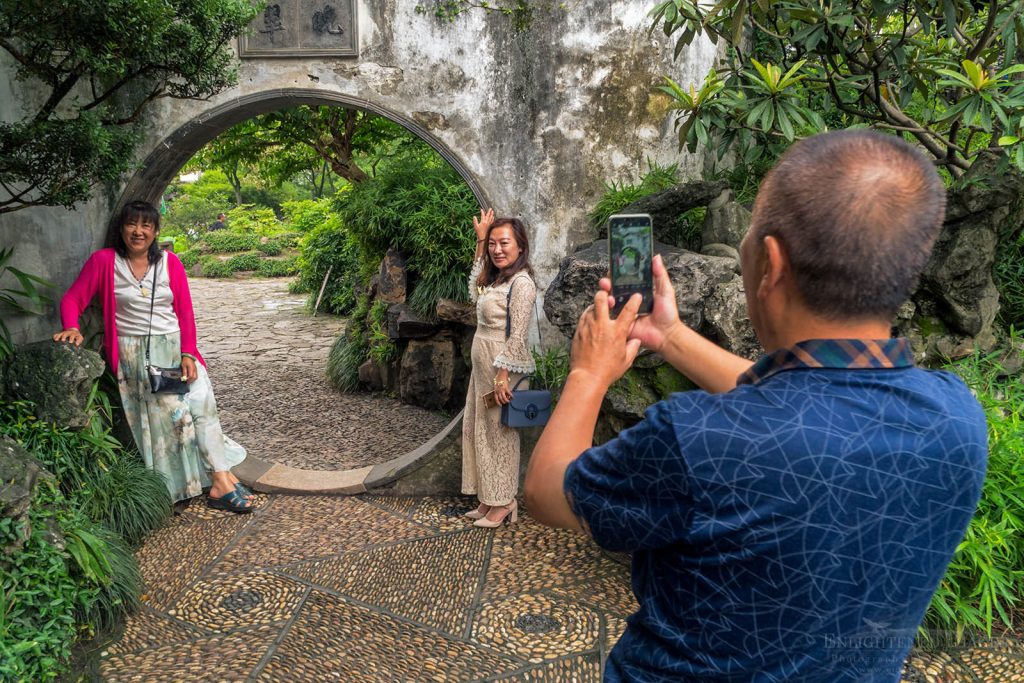 Photo: Visitors in The Humble Administrator Garden, a UNESCO World Heritage Site, Suzhou, Jiangsu Province, China
Photo: Visitors in The Humble Administrator Garden, a UNESCO World Heritage Site, Suzhou, Jiangsu Province, China
After arriving in the middle of the afternoon, checking into my hotel and freshening up a bit, I headed out for an exploratory stroll. I crossed under the railroad tracks on pathway used mostly by pedestrians or folks on bikes or electric scooters. The old part of Suzhou is easy to recognize on maps due to the definitive encasing rectangle of the Waicheng River immediately south of the Suzhou Railway Station. I crossed over the river and made my way south about a mile, passing the North Pagoda which was easily visible standing well above most of the local buildings. From there I turned toward the western city gate. I stopped to sample foods from some of the local sidewalk shops, watched a group of middle-aged women doing Tai Chi to music, and local town folks gathered to dance, play board games, and basically celebrate the end of the day.
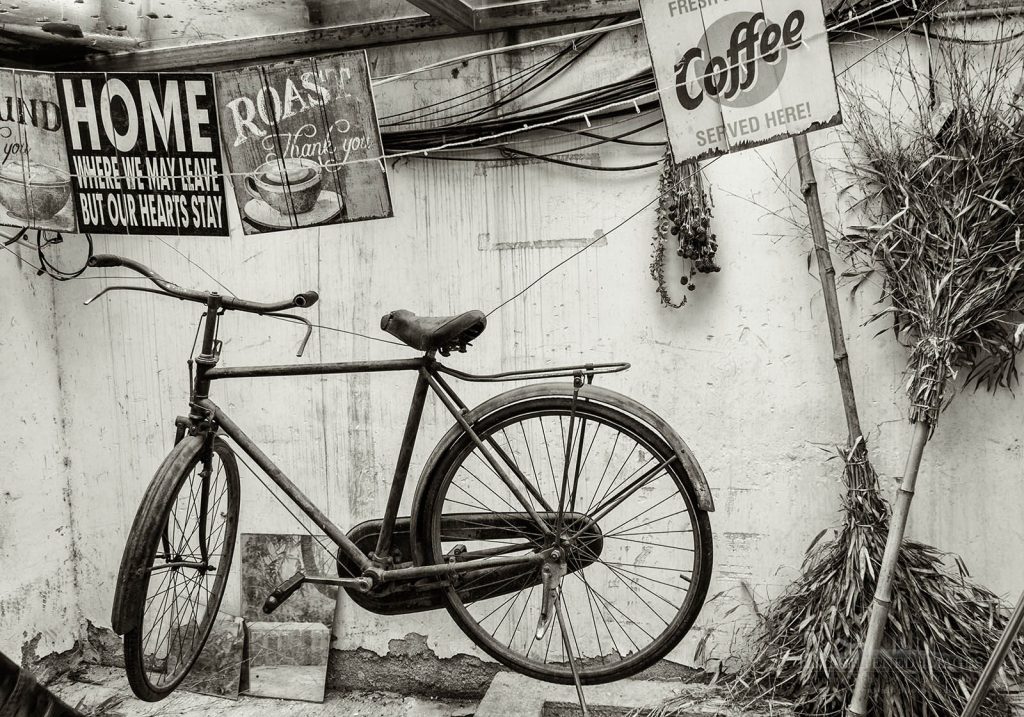 Photo: Bike and English coffee signs in an alley off of Pingjiang Road, Suzhou, Jiangsu Province, China
Photo: Bike and English coffee signs in an alley off of Pingjiang Road, Suzhou, Jiangsu Province, China
As dusk fell, I wandered around the Chaozong Pavillion and then into the Shantang Scenic Area, which is a narrow lane of shops following along the Shantang River. This was one of those spots where the throngs of people would be so dense in spots that you just had to join in the flow of bodies like a school of sardines swimming through a tiny channel. One of the popular attractions here is the Tonggui Bridge. Along the river, there were many food stands, tea houses, silk and souvenier shops, and plenty of young and old couples, as well as families with kids all enjoying the vibrant old town atmosphere. Every so often a wooden water taxi would slowly make its way along the river ferrying families and tourists alike in the warm summer evening air.
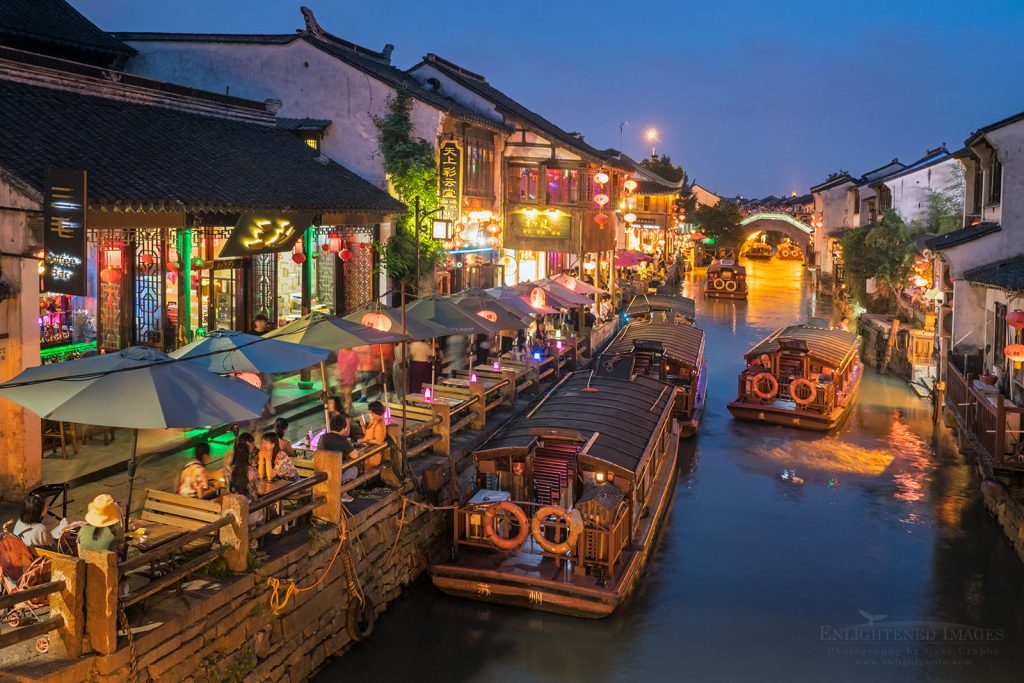 Photo: Evening along the Shantang River from the Tonggui Bridge, Suzhou, Jiangsu Province, China
Photo: Evening along the Shantang River from the Tonggui Bridge, Suzhou, Jiangsu Province, China
It was also here that I got a bit lost for the first time in China, walking more than a mile upriver. One thing my friend told me before I left was that it would be much safer, in general, walking around as a tourist. Here I wound up walking into a dark riverside collection of homes, obviously well out of my tourist element on a narrow, dimly-lit walkway. While it did cross my mind that if I was in a major American urban city carrying a camera, I’d likely be a target for a mugging or worse within a matter of minutes, that level of apprehension was never really a factor despite being alone and lost in a dark, foreign neighborhood in China. I eventually retraced my steps back to a point where I could follow one of the main city roads back toward the train station and my hotel, rounding out a wonderful 6-mile walk which I ended with a Chinese hamburger and a cold beer.
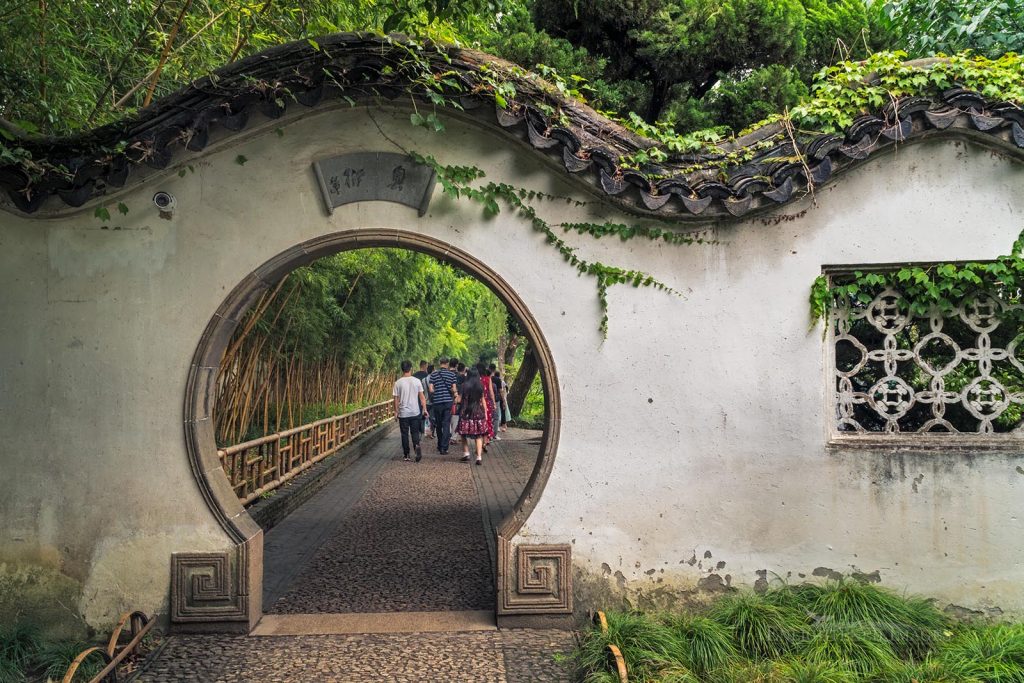 Photo: The Humble Administrator Garden, a UNESCO World Heritage Site, Suzhou, Jiangsu Province, China
Photo: The Humble Administrator Garden, a UNESCO World Heritage Site, Suzhou, Jiangsu Province, China
The next day I woke up to a forecasted rainstorm, so I spent a few extra hours in my room making plans for my next destination, the lakeside resort city of Hangzhou. Once the rain stopped, I headed out walking again, this time heading for one of the best-known of the ancient gardens, The Humble Administrator Garden. I knew the general area where the garden was located. After a short walk along the Waicheng River I navigated a few alleyways and roads before finding the entrance. This was my first time getting an onsite attraction entrance ticket which proved to be fairly straightforward and easy. But even on a wet, gray day there were a lot of people visiting this garden. I was quickly learning that even outside of Shanghai crowds are everywhere. Just like here in the US, summer is the busy tourist season, especially for families when the kids are out of school.
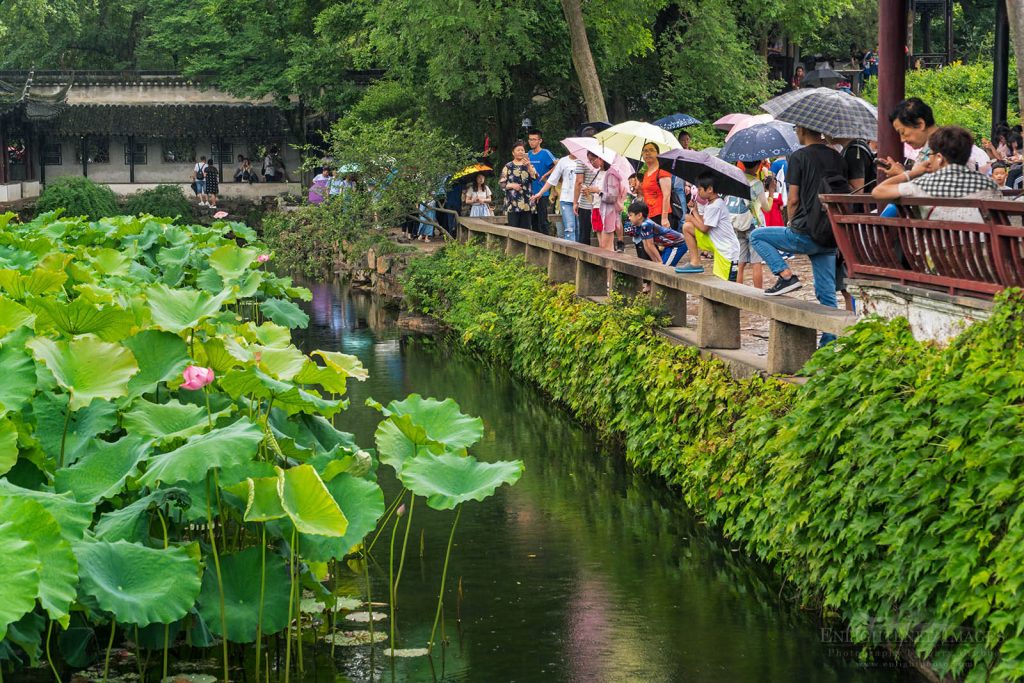 Photo: Visitors in The Humble Administrator Garden, a UNESCO World Heritage Site, Suzhou, Jiangsu Province, China
Photo: Visitors in The Humble Administrator Garden, a UNESCO World Heritage Site, Suzhou, Jiangsu Province, China
The Humble Administrator Garden was built during the Ming Dynasty in the early 1500’s by a retired local government official. The garden covers more than a dozen acres of trees, rocks, water, and pathways. It was easy to spend a few hours walking around with my camera. Occasionally I would get lucky to find a scene without people in it, but more often I would simply resign myself to including people in my shots. It didn’t take being in China for long before I realized this would be the mental adaption that would carry my photography forward; I gave up on feeling a need to get the pristine travel shot of an empty scene and started looking more at the personal experience of interacting with these places.
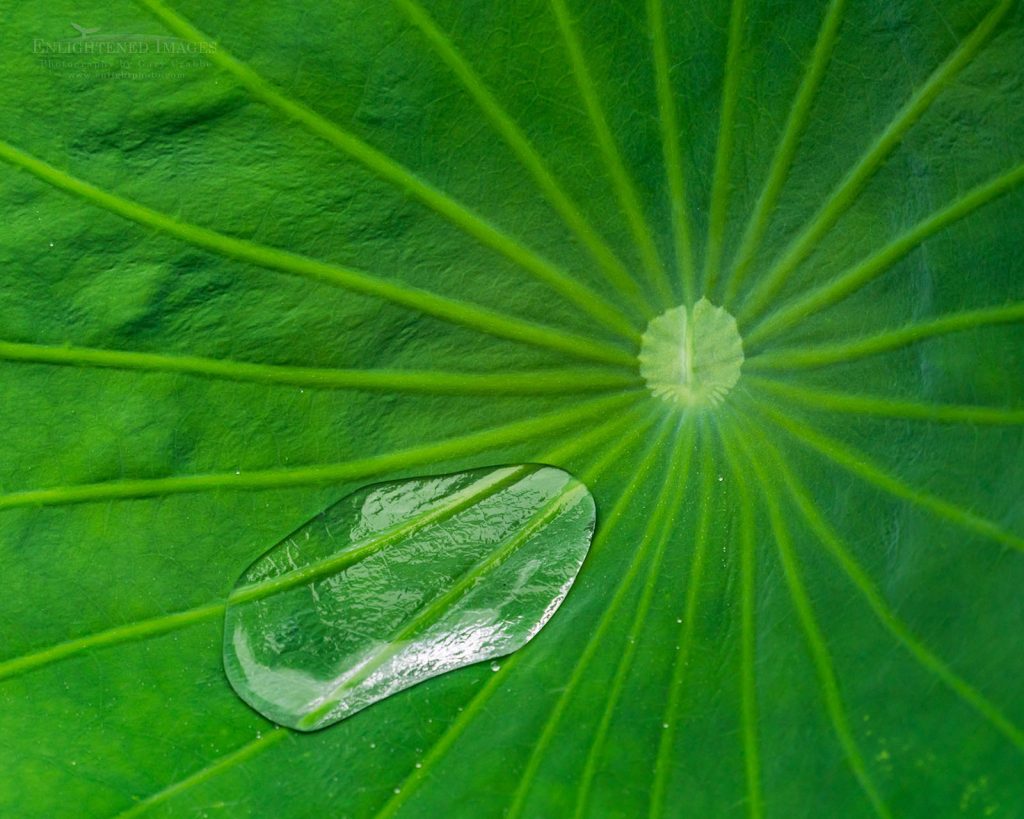 Photo: Water drop on Lily leaf, Lion Grove Garden, Suzhou, Jiangsu Province, China
Photo: Water drop on Lily leaf, Lion Grove Garden, Suzhou, Jiangsu Province, China
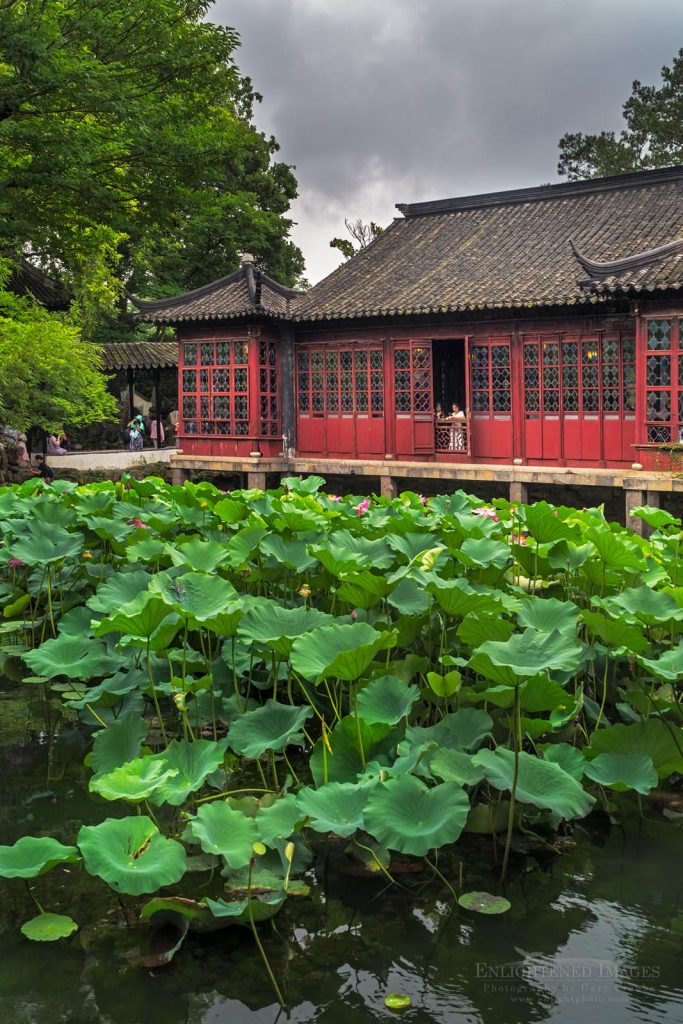 Photo: Visitors in The Humble Administrator Garden, a UNESCO World Heritage Site, Suzhou, Jiangsu Province, China
Photo: Visitors in The Humble Administrator Garden, a UNESCO World Heritage Site, Suzhou, Jiangsu Province, China
 Photo: Visitors in The Humble Administrator Garden, a UNESCO World Heritage Site, Suzhou, Jiangsu Province, China
Photo: Visitors in The Humble Administrator Garden, a UNESCO World Heritage Site, Suzhou, Jiangsu Province, China
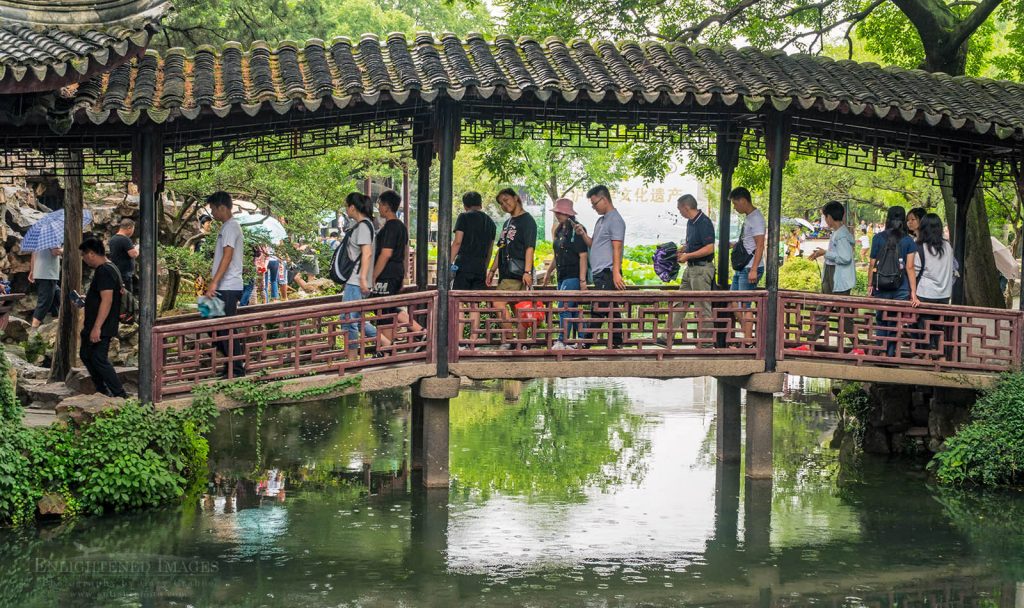 Photo: Visitors in The Humble Administrator Garden, a UNESCO World Heritage Site, Suzhou, Jiangsu Province, China
Photo: Visitors in The Humble Administrator Garden, a UNESCO World Heritage Site, Suzhou, Jiangsu Province, China
After leaving the Humble Administrator Garden, I strolled down a nearby street to visit a second garden, The Lion Grove Garden, which is filled by a courtyard pond and labyrinth of jagged rock outcrops with narrow winding paths and stairways. I even managed to get lost for a few minutes trying to work my way through all the other folks who also seemed a bit lost. The Lion Grove Garden is nearly 150 years older than The Humble Administrators Garden, being first built in 1342 by a Zen monk to honor one of his teachers. The name Lions Grove came from the fact that many of the twisted and gnarled rock shapes seemed to resemble lions.
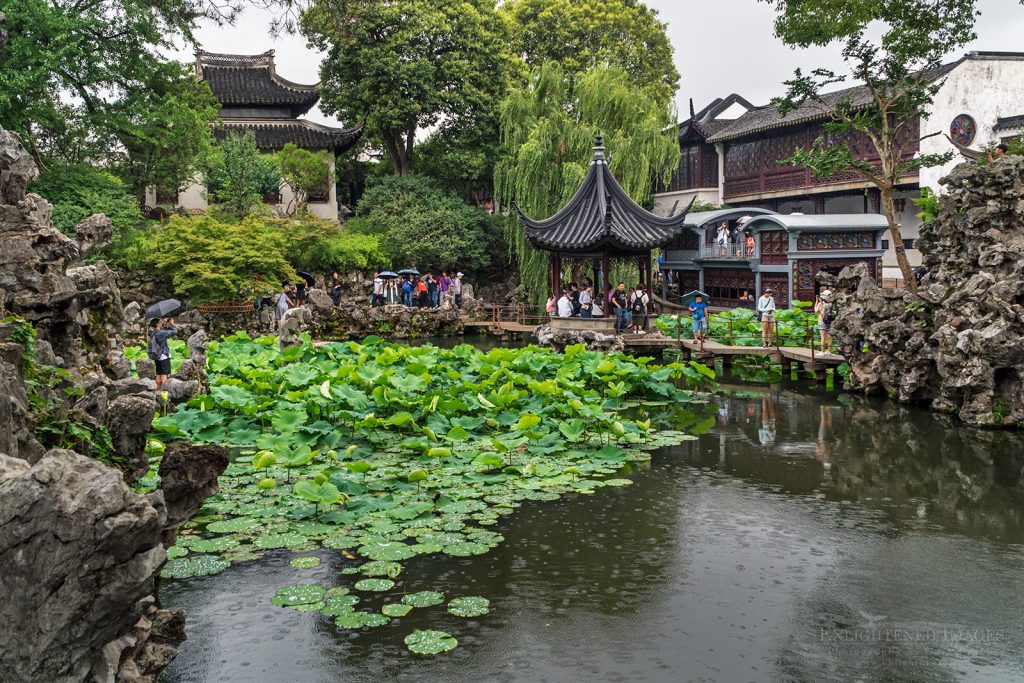 Photo: Lion Grove Garden, Suzhou, Jiangsu Province, China
Photo: Lion Grove Garden, Suzhou, Jiangsu Province, China
It was a little tough to get good photos of the rock garden due to the rain starting to fall again and the visually chaotic nature of the dark rock. Still, there were lots of nice details to shoot in the hour or so I was there, including a young woman posing in traditional dress. (She was a visitor/model who happened to be with a friend/photographer.)
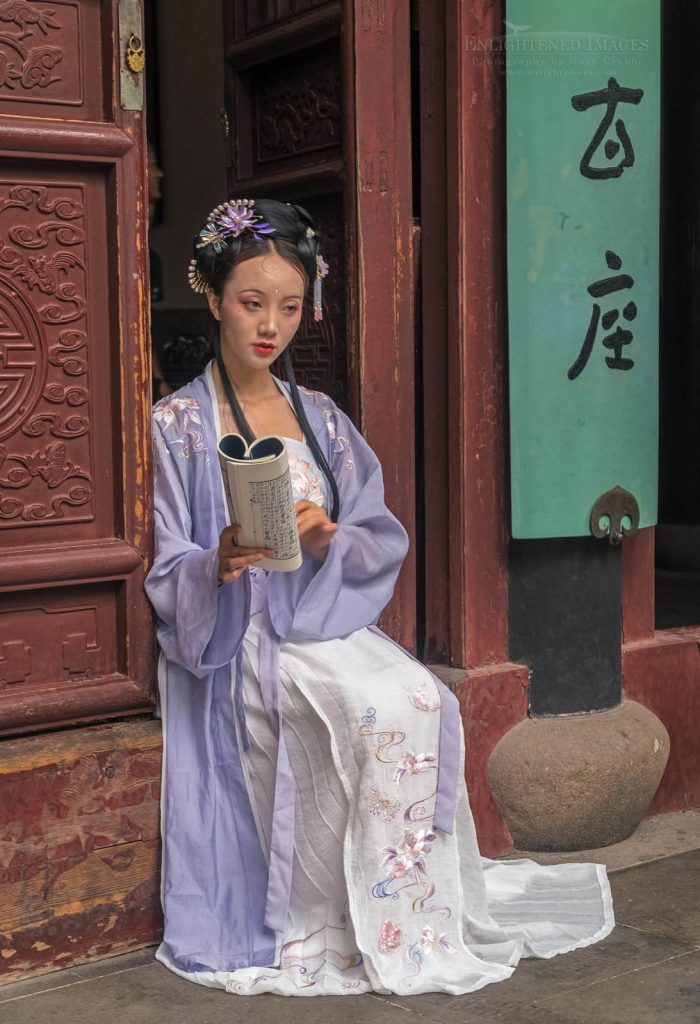 Photo: Woman in traditional dress at the Lion Grove Garden, Suzhou, Jiangsu Province, China
Photo: Woman in traditional dress at the Lion Grove Garden, Suzhou, Jiangsu Province, China
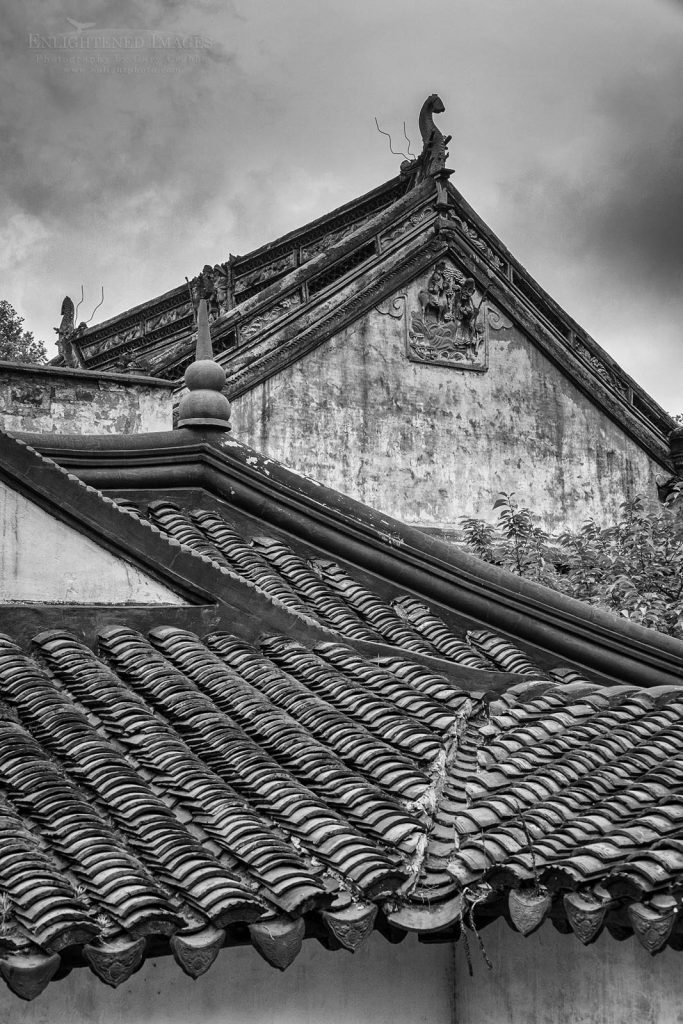 Photo: Roof detail at Lion Grove Garden, Suzhou, Jiangsu Province, China
Photo: Roof detail at Lion Grove Garden, Suzhou, Jiangsu Province, China
After leaving the Lion Grove Garden, I made it a few blocks over to another very popular area along Pingjiang Road. Filled with many small side alleyways, this road is said to be one of the best examples of the historical local neighborhood streets with a history that goes back over two thousand years. I was able to walk for almost two kilometers along the canal, also known as the Pingjiang River, on one side while many small shops and food stalls lined the other. It wasn’t as crowded as the Shantang Scenic Area, but yet it still had a nice balance between having lots of local flavor while still enjoying a slight bit of that evening carnival stroll-type atmosphere. This was a great place to watch the water taxis working their way along the canal while enjoying some of the local street food.
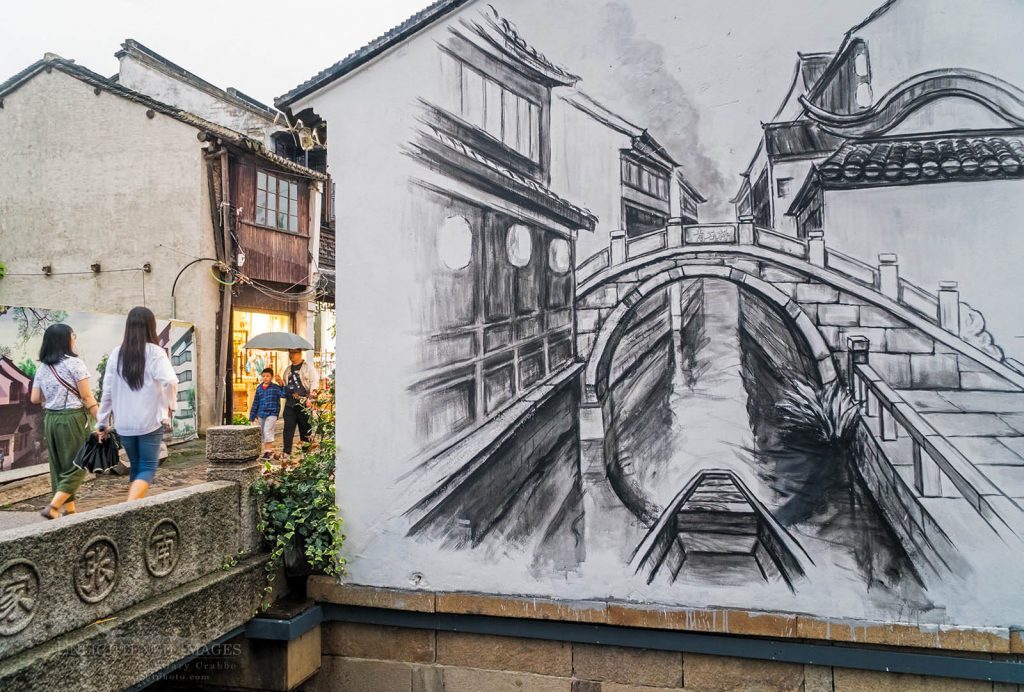 Photo: Street scene artwork along Pingjiang Road, Suzhou, Jiangsu Province, China
Photo: Street scene artwork along Pingjiang Road, Suzhou, Jiangsu Province, China
 Photo: Water taxi in the canal along Pingjiang Road, Suzhou, Jiangsu Province, China
Photo: Water taxi in the canal along Pingjiang Road, Suzhou, Jiangsu Province, China
At the end of another great day of walking, I caught the subway back to the main railroad station where it was just a few minutes further walk to my hotel. The next morning I’d be back on another bullet train taking me to my next destination, Hangzhou.
Finally, I should also mention that for travelers going to Shanghai, Suzhou is one of the most popular and commonly asked about day trips out of the city. In short, yes, it is very easy to get a bullet train out of Shanghai early in the morning, arrive at Suzhou in well under an hour, and with a taxi into the main part of town, you could easily spend most of a full day, or even have dinner in town and make it back to Shanghai by 9pm
Thank you so much for reading if you made it this far, and if you’d like to know when my other posts related to this and other trips are published on my blog, please enter your email address in the box next to the first photo at the top of this post to get free email updates about new material.
—
There’s More to the Story:
Part One: How Doing a Small Favor Turned into Spending Five Weeks in China
Part Two: Two Days in Suzhou & UNESCO Ancient Chinese Gardens
*More coming soon.
Thanks so much for taking the time to look, and I hope you’ll come back again to see more.
~ Gary.
—![]()
 Gary Crabbe is an award-winning commercial and editorial outdoor travel photographer and author based out of the San Francisco Bay Area, California. He has seven published books on California to his credit, including “Photographing California; v1-North”, which won the prestigious 2013 IBPA Benjamin Franklin Gold Medal Award as Best Regional title. His client and publication credits include the National Geographic Society, the New York Times, Forbes Magazine, TIME, The North Face, Subaru, L.L. Bean, Victoria’s Secret, Sunset Magazine, The Nature Conservancy, and many more. In 2018, The USPS selected a nearly-unprecedented seven of Gary’s photographs to become U.S. Postage ‘Forever’ Stamps as part of the O Beautiful collection. Gary is also a photography instructor and consultant, offering both public and private photo workshops. He also works occasionally as a professional freelance Photo Editor.
Gary Crabbe is an award-winning commercial and editorial outdoor travel photographer and author based out of the San Francisco Bay Area, California. He has seven published books on California to his credit, including “Photographing California; v1-North”, which won the prestigious 2013 IBPA Benjamin Franklin Gold Medal Award as Best Regional title. His client and publication credits include the National Geographic Society, the New York Times, Forbes Magazine, TIME, The North Face, Subaru, L.L. Bean, Victoria’s Secret, Sunset Magazine, The Nature Conservancy, and many more. In 2018, The USPS selected a nearly-unprecedented seven of Gary’s photographs to become U.S. Postage ‘Forever’ Stamps as part of the O Beautiful collection. Gary is also a photography instructor and consultant, offering both public and private photo workshops. He also works occasionally as a professional freelance Photo Editor.
Follow me on FACEBOOK – INSTAGRAM – TWITTER
*** If you like this post, I would greatly appreciate it if you’d consider sharing this with your friends using one of the Social Media sharing buttons located at the top or bottom of this post. You can also sign up to receive free updates by email when future posts are made to this blog.
![]()






Absolutely beautiful! The gardens are amazing! The river images are enchanting! The water taxis are so charming to me. Thank you for sharing these fantastic photos!